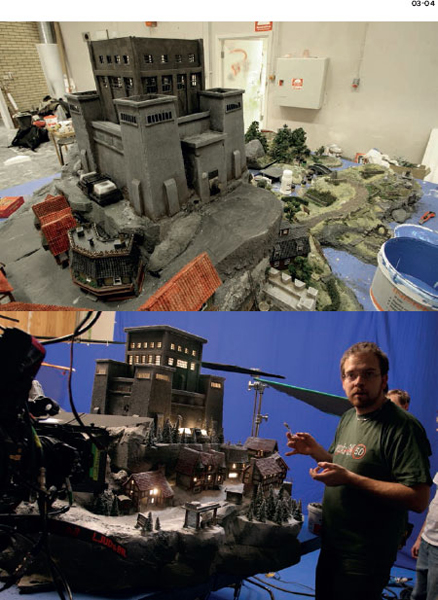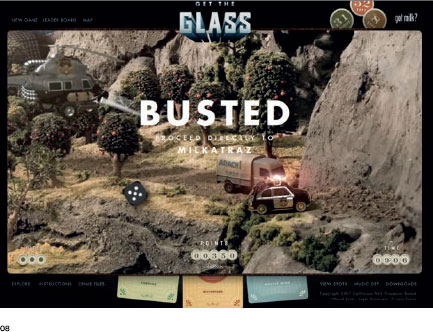California Milk Processor Board
Get The Glass
Goodby, Silverstein & Partners
When we think of website design, we often presume that everything is created digitally – computer-generated graphics and imagery used in place of the hands-on tools of the analogue world. This is not always true, however, with many websites featuring handcrafted elements at the core of their aesthetic. This was very much the case for the website that Swedish digital creative agency North Kingdom constructed as part of a campaign for the California Milk Processor Board.

01-02 At the centre of the Get The Glass website was an island; this was built by hand by the production team at North Kingdom and then shot for the website. These images show the model of the island during the photo shoot.
The main campaign in 2007, by Goodby, Silverstein & Partners in San Francisco, was called Get The Glass, and aimed to highlight the health benefits that milk has to offer, which include healthy hair, help with insomnia, and strong teeth. Rather than take a conventional teaching style approach to impart this information, the agency wanted to create something fun. They came up with a family of characters, the Adachi family, who all suffered from ailments that could be cured if they could only get a glass of milk. A series of TV spots was created, which then drove viewers to an interactive board game online.
‘In the television ads, it was the Adachis’ milk deficiencies that undermined their various attempts to get the glass,’ explains GS&P’s creative director on the project, Will McGinness. ‘In the online board game, we challenged users to aid the Adachis to break into “Fort Fridge” to get the coveted glass of milk by helping them make their way through five regions [each emphasizing one benefit of milk] while being chased by Fort Fridge security.’ The first 4,000 players to complete the game (and avoid being incarcerated in ‘Milkatraz’) won a specially designed glass as a prize.
No matter how well they are designed, it is difficult to get an audience to visit a micro-site for a brand, let alone stay long enough to explore it. Games are one of the few proven solutions to this problem, and can be a clever way of hooking a visitor in long enough to deliver some brand information along the way. To give added charm to their website, and appeal to a family audience, GS&P decided to base their site on the classic board game model.
‘We knew we wanted to bring the world of the Adachi family online and help tell the milk story in an engaging way,’ continues McGinness. ‘Suffice to say, most people aren’t terribly interested in learning about milk. We knew we needed to create an experience that held the user’s attention long enough to teach them about the health benefits of milk. We primarily wanted to capture a younger demographic, but the hope was that we could do something that could potentially engage the entire family. The classic board game seemed like a perfect fit. It’s something that everyone can understand and relate to – everyone is familiar with the basic rules of board games. You roll dice, move your game piece and encounter challenges or questions along the way.’
‘We primarily wanted to capture a younger demographic, but the hope was that we could do something that could potentially engage the entire family. The classic board game seemed like a perfect fit.’



03-06 The production team began by planning the design for the island in Photoshop (shown in image 05). They then built the large island model in their studio, drawing on references such as the movie Beetlejuice and the 1970s Swedish TV show Vilse i pannkakan to devise its look.
The creatives reacquainted themselves with other board games in order to flesh out the narrative of their own online game. ‘Figuring out the game play was a bit of a challenge,’ admits McGinness. ‘We basically went out and bought every classic board game we could think of and had a games night. We started mapping out board game conventions and thought about our story and how we’d fold it into the experience. Then we created a few crude prototypes out of foam core and cardboard. We played them repeatedly and made adjustments until the game play seemed to make sense. Granted, we could have spent six months trying to figure this out, but this loose crash course in board game methodology seemed to work pretty well.’
At this stage, North Kingdom became involved. ‘Generally, we concept and design our interactive work in-house, and then work with one of our production partners to execute the project,’ explains McGinness of the working process. ‘Our best vendors will use the work that we do as a springboard and work with us to take the project to a new level. In the case of Get The Glass, we knew we wanted to create an experience that relied heavily on 3D. So we focused our work on that idea – the general game-play mechanics and design direction. Then we worked closely with North Kingdom in executing the experience. So our role in this particular project ended up being a lot more directional, as they brought the experience to new heights with their design and execution. They were instrumental in the success of the project.’
From early on, North Kingdom was keen to create the island at the centre of the game as a physical model, rather than use digital 3D modelling software. They began by using a computer, however, first mapping out the island in Photoshop before designing a rough 3D version on screen. Then they began the laborious process of building a large island in their studio that would be filmed for the site. They used a number of visual references as inspiration for the island’s look. ‘To find good references is a very important part of the work,’ says Roger Stighall, co-founder of North Kingdom. ‘We found stuff like the physical worlds of [model train sets] Märklin Trains, movies like Beetlejuice, and Vilse i pannkakan, a 1970s Swedish children’s TV programme. But the style itself mostly came naturally. As an art director, you work with so many different 3D artists, model builders, character designers and graphic designers on a project that you never know in the beginning exactly what it will look like in the end. You have to be able to see the beauty in the different parts and hold on to that, and get the other visual parts to merge together.’
07-08 Images from the Get The Glass website reveal how the model island was incorporated into the digital campaign. The interactive board game proved a fun way of entertaining viewers while subtly teaching them about the benefits of drinking milk.
‘As an art director, you work with so many different 3D artists, model builders, character designers and graphic designers on a project that you never know in the beginning exactly what it will look like in the end. You have to be able to see the beauty in the different parts and hold on to that.’
North Kingdom worked closely and successfully with GS&P on the project, though, despite this close collaboration, last-minute adaptations to the narrative proved stressful. One such change was the decision to alter the look of the major building on the model, a castle. ‘The television commercial hadn’t been shot when we were building our island, so we just had some references of how the main building would look, which at the time was a big castle,’ explains Stighall. ‘Three days before the shooting, which we could not move at all, we had a call from our client, saying “the castle is no longer a castle…”. Our client had at this point got footage of how the “castle” would look in the TV commercial [which was quite different]. However, the new style turns out to be much better, I think; it gave the whole island a totally new character.’
North Kingdom was able to complete the changes to the model in time, and filmed all the footage of it in just one day. Then all the elements were brought together in the production of the site. In total, from the first briefing from GS&P to the finished website, the project took approximately five months for North Kingdom to complete. By combining old-fashioned qualities such as modelmaking and a classic board game structure with dollops of digital whiz and interactivity, GS&P and North Kingdom created a hugely popular website. The Get The Glass game received more than four million unique visitors, who spent an average of nine minutes each on the site – ample time for the California Milk Processor Board to get their message across.



